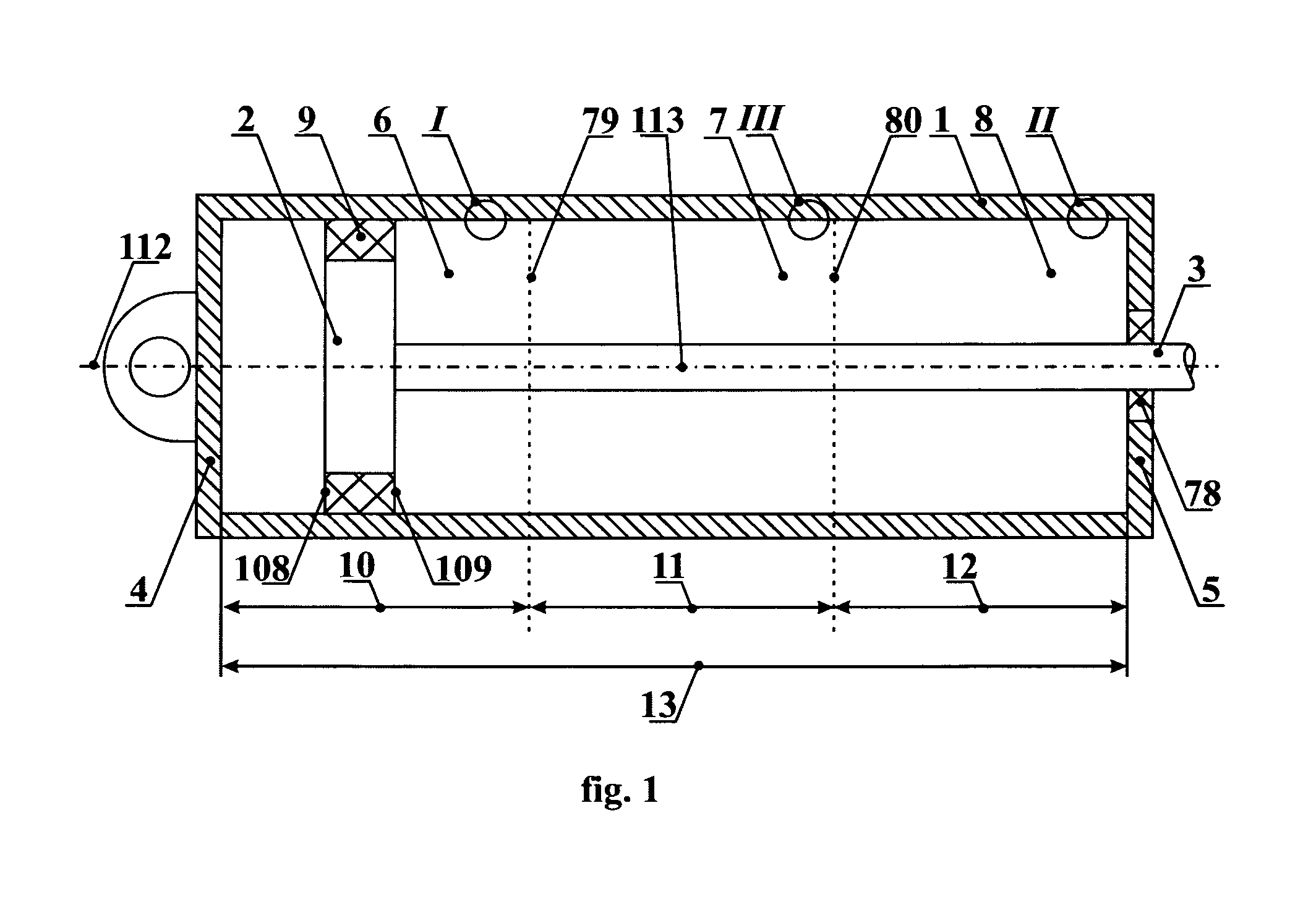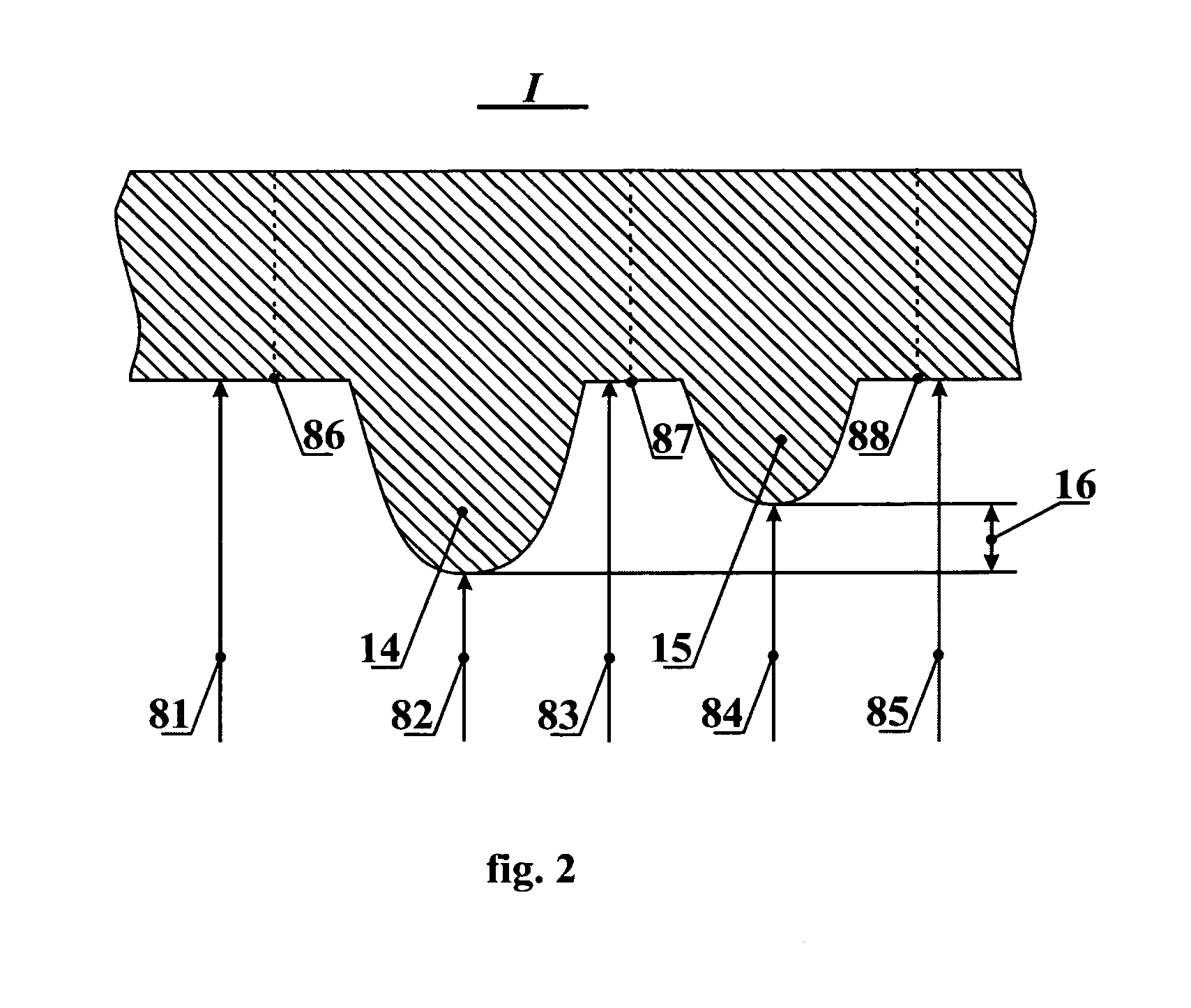Shock absorber for a transportation means
a technology for transportation means and shock absorbers, which is applied in the direction of shock absorbers, braking systems, transportation and packaging, etc., can solve the problems of insufficient increase of force counteracting, and achieve the effects of increasing resistance, avoiding auto-oscillation and resonance regime, and increasing damping efficiency
- Summary
- Abstract
- Description
- Claims
- Application Information
AI Technical Summary
Benefits of technology
Problems solved by technology
Method used
Image
Examples
experiment 1
[0152]The sleeve of the first shock absorber was made according to the prototype. The sleeve of the shock absorber was furnished with a narrowing neck 47, shaped as an element of a circle, which was arranged on the inner surface of a sleeve 46. A length 53 of this element was 50 micrometers, and a reduction of the sleeve's radius 54 was 50 micrometers. A compound piston seal TPS / T was utilized for the shock absorber. It's worth to note that the design of the prototype was also associated with narrowing sleeves, wherein the narrowing section had a length of several millimeters, whereas the inventive sleeves have the length of narrowing sections not exceeding 100 micrometers.
[0153]FIG. 12 shows a sleeve 46, and a portion of the piston with a seal 48. The piston moves towards the direction indicated by a pointing arrow 49, wherein a side surface 111 of the seal 48 faces forward. FIG. 12 also shows a graph located under the picture, which graph illustrates a dependency of a force ‘P’, c...
experiment 2
[0156]The second experiment is illustrated on FIG. 13. The inner surface of a sleeve 57 had two narrowing necks shaped as semi-circles with a width 55 of 100 micrometers equal for both the necks. The distance 56 between the necks 55 was chosen of 50 micrometers. The difference 58 between the radiuses of the necks amounted to 50 micrometers.
[0157]A sleeve 57 is depicted on FIG. 13. The piston 46 having the seal 48 with the side surface 111 are shown on FIG. 12. The piston moves forward, overcoming the resistance of the narrowing necks. FIG. 13 contains a graph located below the picture. The graph illustrates a dependency of a force ‘P’, counteracting the movement of the piston in the sleeve, upon a coordinate ‘1’ of the right side surface 111 of the seal.
[0158]During the movement of piston along the section with the greater diameter, force P had a value of 5 Newton (that corresponds to a level 59 on the graph). During the overcoming the narrowing necks, there were two surges of force...
experiment 3
[0161]The third experiment is illustrated on FIG. 14. The shock absorber comprises a sleeve 63 and a piston (not shown) with a seal 48 having two seal surfaces 110 and 111 (shown on FIG. 12). The sleeve 63 has two narrowing necks, formed by elements outstanding from the sleeve's walls and having a trapezium-like shape (as shown on FIG. 14). The length of each such narrowing neck (summarizing sections 64, 65, and 66) constitutes 150 micrometers. The distance 67 between the two necks is 50 micrometers. As in the previous experiment, the radius difference is 50 micrometers.
[0162]FIG. 14 reflects the movement of piston from the left to the right, i.e. the side surface 111 faces the direction of movement, overcoming the narrowing necks. A graph located under the picture on FIG. 14 shows a dependency of force ‘P’, counteracting the movement of the piston, upon coordinate ‘1’ of the surface 111.
[0163]During the movement of the piston in the piston's section with a greater diameter, force P...
PUM
 Login to View More
Login to View More Abstract
Description
Claims
Application Information
 Login to View More
Login to View More - R&D
- Intellectual Property
- Life Sciences
- Materials
- Tech Scout
- Unparalleled Data Quality
- Higher Quality Content
- 60% Fewer Hallucinations
Browse by: Latest US Patents, China's latest patents, Technical Efficacy Thesaurus, Application Domain, Technology Topic, Popular Technical Reports.
© 2025 PatSnap. All rights reserved.Legal|Privacy policy|Modern Slavery Act Transparency Statement|Sitemap|About US| Contact US: help@patsnap.com



